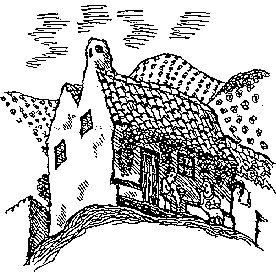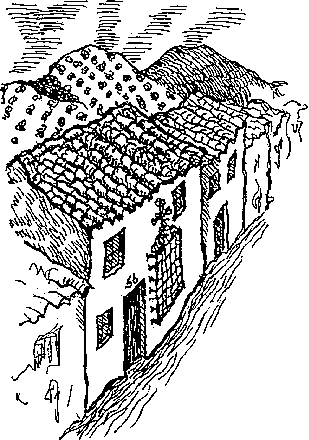
La cacha's real name was Catalina and she grew up a stone's
throw down the hill in her father's house. She was an unwed
mother, which in those days was tantamount to being a
"fallen woman". The neighbours tell me that while
working as a housekeeper for a wealthy farmer across the valley
she was made pregnant by the man's young son and sent home in
disgrace. Back then this was a great tragedy, in spite of the
fact that Catalina was already some 40 years old. Her father
refused to take his daughter back in the family home, but in her
condition couldn't put her in the street either, so he gave her
the other house which stood on his land, just up the hill. He
even insisted on drawing up a deed in her name, as if to erect a
"wall of shame" around her, cutting the 800 square
metres of steep hillside off from the rest of his property. That
is why the house stands on such an unusually small plot, which,
in turn, is why I could afford to buy it. 
There are two things about which Spanish peasants are totally unsentimental: one, as I have learned over the years, is anything remotely related to sexual activity, and the other is water. Catalina's father went so far as to stipulate that she could only use the water which filled her small "aljibe", from an ancient underground channel, for domestic purposes rather than irrigation, and should allow the overflow, or "derrame", to continue on down by means of another "venero" to fill his own cistern, where he used it to water his orchard at the bottom of the valley. There is a clause in the current deeds of both houses which was inherited from this curious arrangement, according to which the aljibe itself does not belong to me but, rather, to the man who bought it from the heirs of Catalina's unforgiving father. But the notary assures me that such "home-made" clauses ("I hereby sell you this field but I retain the right to graze my donkey on it from March to June...") were common in the times when an escritura was often just a bit of paper signed with thumbprints, and that due to their irrational nature they are rarely enforced.
Catalina made a living by raising chickens and selling the eggs in the market. I often imagine the suffering, between these walls, without solar-powered light bulbs or butane-burning refrigerators, of the unmarried woman alone with her child; but my bricklayer and the passing shepherd prefer to remember the good times they had as young men at la cacha's house, which may well have included clandestine visits under cover of darkness. This is precisely why the neighbours (especially the womenfolk) looked down on Catalina as a "marrana", or slut - a woman without a husband was a threat to every Christian household. But they all used to enjoy the "bailes" which she gave to make some extra money; my neighbour Alfonso fondly recalls that someone would always bring along an accordion or a guitar so that the local swains could steer the marriageable "mozuelas", at less than arm's length if they dared, through a rasping pasodoble - here in the same raftered room where I am now writing by the fire.
I am told that her son, Celestino, is now a father of no less than twelve children of his own, and lives in another farm near the road to Alcala; Catalina moved out when he married, in the early 60's, and ended her days at a relative's home near Puerto Lope, at a great age. She sold the house to a family of farm labourers, or "jornaleros"; most of the sons and daughters had emigrated to Barcelona by the time the father was killed in the stable (now my downstairs bedroom) by a mule, which reared up and drove an iron yolk into his heart. His widow and children immediately moved away and put the house up for sale, even though I myself only learned of the tragedy years later. Perhaps it was because they superstitiously wanted to be rid of it that they asked for so little - less, in fact, than what I paid for the second-hand "dos caballos" delivery van which I had just bought from Pedro Romero. To paraphrase an old saying, the desire for money is great, but the fear of death is even greater...
 As the name indicates, the cortijo is surrounded
with seven olive trees (as well as ten almond trees, two fig
trees, one pomegranate and one quince tree; it also has a
"chumbera", or fig-cactus). I thought that the Farm
With the Seven Olive Trees sounded suggestively romantic, but to
the villagers the name seems laughably modest, since any
self-respecting finca has at least several hundred of the
precious plants, not just seven.
As the name indicates, the cortijo is surrounded
with seven olive trees (as well as ten almond trees, two fig
trees, one pomegranate and one quince tree; it also has a
"chumbera", or fig-cactus). I thought that the Farm
With the Seven Olive Trees sounded suggestively romantic, but to
the villagers the name seems laughably modest, since any
self-respecting finca has at least several hundred of the
precious plants, not just seven.
I had no idea of how to build, of where plaster should be used and where cement, or how a door or window frame were installed or pipes were laid, so I hired one of Rocio's student friends, who was studying to be an architect's assistant (aparejador), to help me direct the six workers who were to make the place suitable for semi-civilized summertime living. But even resourceful Jose could not protect me from all the "unforeseeables". As soon as we began work, the venerable "venero" proved to be a springtime-only affair and ran dry, so that for the next six weeks (which was exactly three times as long as my workers assured me the whole operation would take), I had to shuttle three or four 200-litre tanks of water a day down the bumpy road, from a fountain two miles away. Pedro Romero's "furgoneta" heroically managed to get me back to Paris by the time winter set in, but there it was diagnosed as foutue and sold for scrap. It simply never occurred to me that construction requires not only sweat and stone, but, also, lots of water...
We built a marvellous fireplace like a great white toadstool to replace the painted flat one, a kitchen where the main bedroom had been (the house had none - they cooked in a hut outdoors); we bored through the 2-foot thick walls to make windows for the somber rooms and created an extension to house the bathroom which, in that already distant year of 1985, was the largest in Montefrio at 9 square metres - with a family-sized tub, thought to be somewhat fanciful for a house which had no supply of water... We rebuilt the long porch, which had collapsed, and covered the fake-marble floor tiles with brick-red "catalanas". However, I have a great defect, which is impatience, and by the end of a seemingly endless summer of dust, heat and sweating workmen - who never missed a chance to let me know that they thought I was completely mad for not tearing the whole thing down and building a snappy new "chale" - I was so fed up that I wished I had never had the idea of buying a house in the first place.
But when I returned to Spain the following spring, I had forgotten all that and discovered, for the first time, the thrill of having a house of my own, a place on which I had left my own personal imprint. It was, and is, like a second skin, without which I feel strangely naked. And the view from the porch of Parapanda Mountain was so beautiful that I could scarcely tear myself away from my deck chair, especially when the setting sun made it glow as if it had been baked in a kiln, like a great incandescent lump of terra cotta... However, I had already made plans to visit old friends in Brazil, and a few months later was off again.
Although I crossed the Atlantic several times in the interim, it would be three years before I returned to live in my house, in the company of a handsome Brazilian woman and our chubby brown baby girl, Nina. From then on - the summer of 1989 - I set about making it suitable for permanent residence.
This began with water. The chances of digging a well with an adequate year-round supply of water seemed so small, from what the locals told me, that I audaciously decided to lay over one mile of black PVC pipe and hook up to the village water system. This required having a steam shovel dig a metre-deep trench across several olive groves, after obtaining the owners' authorization. The whole operation cost me more than the original price of the house, and there was no guarantee that it would work, since Montefrio's water supply (initially pumped from a deep well in the mountains) comes from a holding tank on the hill above the village, from which it "falls" down by force of gravity. Since my house is almost as high as this holding tank, and several miles away with numerous rises and depressions in between, I could only guess, from visual sightings using a carpenter's level attached to a long metal rod, that the "desnivel", or difference in level - four or five metres at the most - would be sufficient for the flow to reach the top of my own reserve tank on the roof of the house. And my guess was correct, making me our water company's highest situated and furthest removed customer...
There seemed - and ten years later there still seems - to be little chance of getting hooked up to the local electrical grid, because my farm is the only inhabited house for several kilometres around and a transformer just for me would be extremely costly. So I acquired four photovoltaic panels, a couple of car batteries and a set of 12 volt incandescent lights, as well as a petrol generator for rainy days and electrical appliances. Sometimes I joke that the farm should be called El Cortijo de los Doce Voltios! It all costs me a great deal in burned-out batteries and fuel, but it allows me to live comfortably where I want to be... Since the mile of dirt road turns to mud after a few minutes of rain, I purchased a small Russian-made land vehicle which can crawl over any amount of damage caused by landslides and flash floods; my Lada Niva also costs me a great deal in petrol, but I wouldn't give it up for anything.
The telephone was my greatest concern, since I was planning to resume work as a free-lance translator and interpreter, after a prolonged sabbatical. I put in my petition to the rural installation department in Granada, where I was told that I would spend several years on the waiting list. While there I happened to make friends with the refined, spinsterly type in charge who, in the course of the conversation, declared herself greatly interested in my pen and ink drawings. I invited her to lunch at a nearby restaurant so that we could look at them together, and we were soon on the best of terms. I was amazed to wake up one morning a few months later to see a team of men erecting a row of 22 telephone poles leading straight to my little house; and dear Carmen saw to it that I did not have to pay for a single one of them.